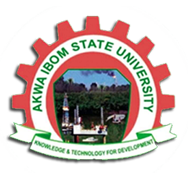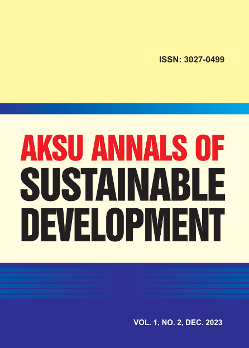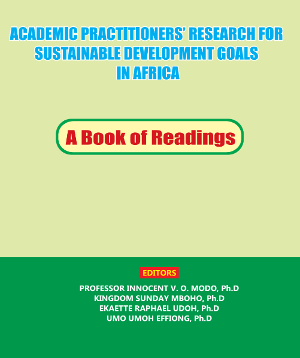CLIMATE CHANGE AND ADOPTION OF INDIGENOUS METHODS OF COPING STRATEGIES AMONG CASSAVA FARMERS IN AKWA IBOM STATE, NIGERIA
DOI:
https://doi.org/10.60787/AASD-v2i1-33Keywords:
Indigenous methods, Climate change, Cassava farmersAbstract
The study assessed the level of adoption of indigenous methods of climate change among cassava farmers in Akwa Ibom State, Nigeria. Primary data were collected with the aid of a structured questionnaire and responses recorded during focus group discussion session. A Sample size of 180 farmers was randomly selected for the study. Data were analysed using descriptive statistics. Findings revealed that reveals that 53.3% of the respondents were male while 46.7% were female. A large proportion (59.4%) of the respondents was within the age range of 40 -50 years. The mean age for the farmers in the study area was 40 years. With regards to education, a great proportion 98.9% of the respondents had acquired formal education. With regards to adoption level, seventeen (17) sampled strategies were presented out of which twelve (12) strategies were highly utilized based on their level of preference. These include mulching(x̄= 3.90), organic manure (x̄= 3.83), mixed cropping (x̄= 3.83), cover crops(x̄= 3.82 ),cultivation of early maturing varieties(x̄= 3.80),tillage systems (x̄= 3.77), improved varieties(x̄= 3.71), relay cropping (x̄= 3.68), total dependence on rainfall(x̄= 3.65), early planting (x̄= 3.30),cultivation of pests and diseases resistant varieties (x̄= 3.28 ) and intercropping (x̄= 3.13). Hypothesis test using T-test and composite index reveals there was difference in mean that was statistically significant at 5.0% level of probability. Study recommended that indigenous methods of climate change should be included in the curriculum of agricultural science and undergraduates studies.
Downloads
References
Aboajah, F.N., Onjewu, S.S., Chia, J.I. &Okeme, S. (2018).
Socioeconomic Determinants of Cassava Production in
Benue State, Nigeria.International Journal of
Environment, Agriculture and Biotechnology (IJEAB),
Vol-3, Issue-2.
Ajaero, C, K, Akukwe, T.I. , Asuoha, G.C. (2013) Climate
Change: Concepts and issues in R.N.C. Anyadike, I.A.
Madu and C.K. Ajaero (eds) Climate Change and the
Nigerian Environment. Conference Proceedings of
Department of Geography University of Nigeria,
Nsukka.
Ajani, E. N, and Onwubuya E. A., (2013) "Analysis of use of
improved cassava production technologies among
farmers in Anambra state, Nigeria."Wudpecker Journal
of Agricultural Research 2, no. 12 (2013): 335-341.
Ajayi, J. O., 2015. "Effects of Climate Change on the
Production and Profitability of Cassava in the Niger
Delta Region of Nigeria ," AGRIS on-line Papers in
Economics and Informatics, Czech University of Life
Sciences Prague, Faculty of Economics and
Management, vol. 7(2), pages 1-9, June. Handle:
RePEc: ags:aolpei:207061 DOI:
22004/ag.econ.207061
Akinro, A. O., Opeyemi, D. A., and Ologunagba, I.B (2018). Climate Change and Environmental Degradation in the Niger Delta Region of Nigeria:Its vulnerability, impacts and possible mitigations. Research Journal of Applied Sciences. 3 (3); Pp 167-173.
Akpodiogaga P. and Odjugo O. (2018) Global and regional
analysis of the causes and rate of Climate in R.N.C.
Anyadike, I.A. Madu and C.K. Ajaero (eds) Climate
Change and the Nigerian Environment. Conference
Proceedings of Department of GeographyUniversity of
Nigeria, Nsukka.
AmbarawatiG.A,Wiyaaya,M.A, and Budiasa, I.W (2018). Risk
mitigation for cassava production through Agricultural
Insurance farmers’ perspectives Journal Manajemen&
Agribusiness 15(2): 128-135.
Bassey, N E ; Akpaeti, A. J Udo, U J. (2014) "Labour Choice
Decisions among cassava crop farmers in AkwaIbom
State, Nigeria" published in International Journal of
Food and Agricultural Economics ISSN2147-8988
Vol.2No.3pp.145-156.
Byju G. and Suja G. (2019) ''Mineral nutrition of cassava''
Central Tuber Crop Research Institute,
https://www.academia.edu/41642662/Mineral_nutriti
on_of_cassava.
Costa, C., and Delgado, C. (2019).The Cassava Value Chain in
Mozambique. License: Creative Commons Attribution
CC BY 3.0 IGO. Washington, DC: World Bank. doi:
1596/31754
Downing T.E., Ringius L., Hulme M. &Waughray
D., 2017, Adapting to climate change in Africa.
Mitigation and adaptation strategies for global
change Vol. 2, 19-44.
Edamisa I., Taiwo E. M., IgbekeleA ,andKemisola A
C. (2020) Cassava production in Nigeria:
trends, instability and decomposition
analysis (1970–2018). Published online
Oct 13. doi: 10.1016/
Effiong U., Udoyen G., and Udoh, E.
(2021).Ecological Determinism and
Prospects of Ecotourism Development in the Niger
Delta, Nigeria.AKSU Journal of Social
Sciences, 1(1), 275-286.
Effiong U., Udousung I. and Udoh E. (2018).
Herdsmen/Farmers Crisis and Rehabilitation of
Victims:
A Study of Middlebelt-Nigeria.UyoJournal of
Sustainable Development, 3(2), 163-169.
Ekanem, Jemimah T. and B. I. Ekerete (2018).ICT
Utilization among Cassava Farmers in PeriUrban Areas of AkwaIbom State, SouthSouth Nigeria. JOURNAL OF COMMUNITY
AND COMMUNICATION RESEARCH ISSN:
-3318Accessible online at
www.jccr.org.ng Volume 3, No. 1June.
Pp. 50-56.
Essiet, D. (2018). Boosting cassava production
throughout the empowerment (Available
online the nation-online-ng-net-boostingcassava-production-youth empowerment).
FAO (2015). Climate Change and Food Security:
Risks and Responses.American Journal of
Climate Change, Vol.10 No.4
FAO . (2018). Food Outlook - Biannual Report on
Global Food Markets – November 2018.
Rome; p. 104. http://www.fao.org/3/
ca2320en/CA2320EN.pdf License: CC BYNC-SA 3.0 IGO. [Google Scholar]
FAO. (2021). ''The impact of disasters and crises on
agriculture and food security: 2021''. Rome
https://doiorg/104060/cb3673en
FAOSTAT.(2019). Food and Agriculture Data.
http://www.fao.org/faostat/en/#data/ [
Google Scholar]
Federal Ministry of Environment Special Climate
Change Unit.(2019) National Adaptation
Strategy and Plan of Action on Climate
Change for Nigeria (NASPA-CCN).Building
Nigeria’s Response to Climate change
(BNRCC).
Food and Agricultural Organization (FAO),
(2015).Food outlook, biannual report on
global food markets. United Nations. P.32.
Available at www fao.org/contactus/licencerquest
Ibok, O. W., I. C. Idiong, I. N. Brown, I. E. Okon and
U. E. Okon, (2014). Analysis of food
insecurity status of urban food crop farming
households in Cross River State, Nigeria:
AUSD Aapproach. J. Agric. Sci., 6:132-141.
Idowu, A.. .A, Ayoola S., O, Opele A.I and
Ikenweiwe, B. N. (2019) Impact of Climate
Change in Nigeria: Iranica Journal of Energy
& Environment 2 (2): 145-152.
Ifabiyi, I. P (2013): Impacts of climate change on
water resources: Impacts and adaptation.
National Water Capacity Building Network,
North Central Regional Centre (NWRCBNetNC) Ilorin (eds).63-83
Kemi, A. A. and Olusegun, A. J. (2020). Climate
Change impact on cassava agriculture in
MaduawuchiObialo (2020)''Full list of all cash crops
in Nigeria''.Published by The Nigerian guide.
https://nigerianguide.com.ng/full-list-of-allcash-crops-in-nigeria/
Martin G, Webb R J, Chen C, Plowright R K, Skerratt L F
(2017) Microclimates might limit indirect spillover
of the bat borne zoonotic Hendra virus. Microbial
Ecology 74:106–115.
https://doi.org/10.1007/s00248-017-0934-x
National Population Commission (NPC) (2006) Nigeria
National Census: Population Distribution by Sex,
State, LGAs and Senatorial District: 2006 Census
Priority Tables (Vol. 3).
http://www.population.gov.ng/index.php/
publication/140-popn-distri-by-sex-state-jgas-andsenatorial-distr-2006
National Research Council, (2005). Mineral Tolerance of
Animals, second revised edition. National Research
Council of the National Academies, The National
Academies Press, Washington D.C.
Nwaobiala, C. U. and Nottidge, D.O. (2013).Effect of
climatic variables on cassava farmers’ production in
Abia State, Nigeria.Nigerian Journal of Agriculture,
Food and Environment, (9)4: 57-62.
Nwaobiala, C.U. and Nottidge, D.O. (2013) Effect of
Climatic Variables on Cassava armers’ Production in
Abia State, Nigeria. Nigerian Journal of Agriculture,
Food and Environment, 9, 57-62.
Ojimba T. P. (2017) ''Cost of production and Resource-use
efficiency among small scale cassava
farmers in Igbo Etche Rivers State, Nigeria: https://d
oi.org/10.26765/DRJAFS.2017.5701 Vol. 5(12),pp.
-400 ISSN 2354-4147.
Okezie, C. A., & Okorie, N. U. (2009).Climate Variability and
Change. In Implication for household food security in
Agricultural society of Nigeria 43rd Annual
Conference.
Okogbenin E., Marin J., Fregene M. (2006). An SSR-based
molecular genetic map of cassava.Euphytica 147,
–440 10.1007/s00122-010-1520-5 [ Cross Ref ] [
Google Scholar ]
Okon E. M, Falanaa B.M.,SolajS.O,Yakubu
S.O.,Alabi O.O., Okikiola B.T., Aweb,
T.E., Adesinaa,B.T., Edeme A.B.,
Kipchumbae A.K. (2018). "Systematic
review of climate change impact
research in Nigeria: implication for
sustainable development"
https://doi.org/10.1016/j.heliyon.2021
.e07941
Okorie, NU.,Umoh, I., and Okon, UE., (2023).
Analysis of Climate Variabibility Coping
Strategies
Used by Arable Farmers in Abak Agricultural Zone
of AkwaIbom State, Nigeria. IN: Ayandele, IA, 287-
Okorie, N. U., Ekanem, J. T. and Okoro, G. I.
(2020).Gender-Based Analysis of Technical
Efficiency of Oil Palm Farmers and the Implication
for Sustainable Development in AkwaIbom
State.Journal of Agricultural Economics, Extension
and Science. 6(2): 124 – 137.
Okorie, NU.,Okon, UE., and Nkeme, KK. (2022).
Agricultural Mechanization Available for Cassava
Processing Operations in AkwaIbom State,
Nigeria.Journal of Community & Communication
Research, 7(2), pp.340-346.
Oladipo, E.O. (2015). An indication of abrupt change of
rainfall and it potential impact on energy
development in Nigeria. In: Umolu, J. C. (ed).
Global Climate Change: Impact on Energy
Development. DAMTECH Nigeria Limited, Nigeria.
Tambudzai, Mupakat (2017). Cassava production as a
climate change adaptation strategy in Chilonga
Ward, Chiredzi District, Zimbabwe. Journal of
Disaster Risk Studies. January 2017 DO:
/jamba.v91.348
TambudzaiMupakati and Vincent I. Tanyanyiwa (2017)
''Cassava production as a climate change
adaptation strategy in Chilonge ward, Chiredzi
District, Zimbabwe.Doi: 10.4102/mamba.v9:1.348
Tandzi N. L. and Mutengwa S C. (2020) ''Factors affecting
yield of crops'' Published in the Journal of
Agronomy, climate change and food security. DOI:
5772/intechopen.90672
Thakur S, Negi VS, Pathak R, Dhyani R, Durgapal K, Rawal
RS (2020) Indicator based integrated vulnerability
assessment of community forests in Indian west
Himalaya. Forest Ecology and Management
:117674
Udoh, V.C., Udoms, B.E and Atakpa, O.E.
(2024).Women, agriculture and socioeconomic development of AkwaIbom State,
Nigeria, 2010-2023. International Journal of
Research and Innovation in Social Sciences,
(4), 660-673.
Udousung, I. J., Nkeme, K. K., Umoh I., and
Robson , U., (2015). Awareness of
Traditional and orthodox methods of
Poultry disease control among Farmers in
AkwaIbom and Cross River States, Nigeria.
Nigerian Journal of Agriculture, Food and
Environment 11(2):38-45
Udousung, I. J., Udoumoh I. D. And Effiong, U.
U.,(2018). "Extent of adoption of indigenous
methods for the treatment of malaria
among cassava farmers in AkwaIbom" Aksu
journal of agricultural economics, extension
and rural development.Aksu JAEERD 1 (1):
– 56, 2018
Umoren, A. A.;Akpan, S.B. and Udoh E.J., (2014).
Analysis of Agricultural Credit Guarantee
Scheme Loans Default among Beneficiaries
in AkwaIbom State from1990- 2015.African
Journal of Agricultural Economics and Rural
Development,2(2):121-128.
Bausch, T., &Koziol, K. (2020). New policy
approaches for increasing response to
climate change in small rural
municipalities. Sustainability, 12(5),
https://doi.org/10.3390/su12051894
Viduranga Y. Waisundara (2018). ''Introductory
chapter: Cassava as a staple food''. Doi:
5772/intechopen.70324.
Olutosin A Otekunrin and Barbara Sawicka (2019).
“Cassava, A st Century Staple Crop: How
can Nigeria Harness its Enormous Trade
Potentials?”.Acta Scientific Agriculture .8
: 194-202 (ISSN: 2581-365X)
Rahman, S. A. and J. F. Alamu, (2003).Estimating
the level of women interest in agriculture
the application of logit regression model.
Nig. J. Sci. Res., 4: 45-49.
Published
Issue
Section
License
Copyright (c) 2024 AKSU Annals of Sustainable Development

This work is licensed under a Creative Commons Attribution-NonCommercial-NoDerivatives 4.0 International License.
Manuscript content on this site is licensed under Creative Commons Licenses. Authors wishing to include figures, tables, or text passages that have already been published elsewhere are required to obtain permission from the copyright owner(s) for both the print and online format and to include evidence that such permission has been granted when submitting their papers. Any material received without such evidence will be assumed to originate from the authors.





 ICIDR Publishing House
ICIDR Publishing House